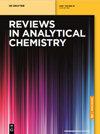Analytical methods for determination of glutathione and glutathione disulfide in pharmaceuticals and biological fluids
IF 3.6
3区 化学
Q2 CHEMISTRY, ANALYTICAL
引用次数: 22
Abstract
Abstract Glutathione is a natural tripeptide that plays a major role in different physiological processes in the human body. Determination of glutathione in different body fluids and tissues is essential for early diagnosis and follow-up of various diseases. The assay of glutathione is problematic because of the high polarity, the limited stability, and the aliphatic structure, which lacks the appropriate chromophore for UV detection. A number of methods have been reported for determination of glutathione using different techniques. High-performance liquid chromatography was employed in both reverse phase and hydrophilic interaction modes. Electrochemical methods exploited the redox activity of glutathione to allow for quantification by different electrodes after chemical modification, including glassy carbon, carbon paste, and nanocomposite electrodes. Capillary zone electrophoresis was used with less need for derivatization which makes it simpler, faster, and more economic. A number of nanosensors and probes have been developed to assay glutathione in biological fluids using semiconductor nanoparticles, quantum dots, genetically engineered green fluorescent probes, and new derivatives of known dye classes. This work is an updated review of the methods of analysis of glutathione and glutathione disulfide in pharmaceuticals and biological fluids with more emphasis on the technical problems and the assay artifacts.药品和生物液体中谷胱甘肽和谷胱甘肽二硫化的测定方法
谷胱甘肽是一种天然的三肽,在人体的不同生理过程中起重要作用。测定不同体液和组织中的谷胱甘肽对各种疾病的早期诊断和随访至关重要。谷胱甘肽的测定存在问题,因为其极性高,稳定性有限,脂肪族结构缺乏适合紫外检测的发色团。许多方法已经报道了测定谷胱甘肽使用不同的技术。在反相和亲水两种相互作用模式下均采用高效液相色谱法。电化学方法利用谷胱甘肽的氧化还原活性,允许通过化学修饰后的不同电极进行定量,包括玻璃碳、碳糊和纳米复合电极。采用毛细管区带电泳,无需衍生化,更简单、快速、经济。利用半导体纳米粒子、量子点、基因工程绿色荧光探针和已知染料类的新衍生物,已经开发了许多纳米传感器和探针来测定生物液体中的谷胱甘肽。本文对药物和生物液体中谷胱甘肽和谷胱甘肽二硫的分析方法进行了综述,重点介绍了技术问题和分析伪影。
本文章由计算机程序翻译,如有差异,请以英文原文为准。
求助全文
约1分钟内获得全文
求助全文
来源期刊

Reviews in Analytical Chemistry
化学-分析化学
CiteScore
7.50
自引率
0.00%
发文量
15
审稿时长
>12 weeks
期刊介绍:
Reviews in Analytical Chemistry publishes authoritative reviews by leading experts in the dynamic field of chemical analysis. The subjects can encompass all branches of modern analytical chemistry such as spectroscopy, chromatography, mass spectrometry, electrochemistry and trace analysis and their applications to areas such as environmental control, pharmaceutical industry, automation and other relevant areas. Review articles bring the expert up to date in a concise manner and provide researchers an overview of new techniques and methods.
 求助内容:
求助内容: 应助结果提醒方式:
应助结果提醒方式:


